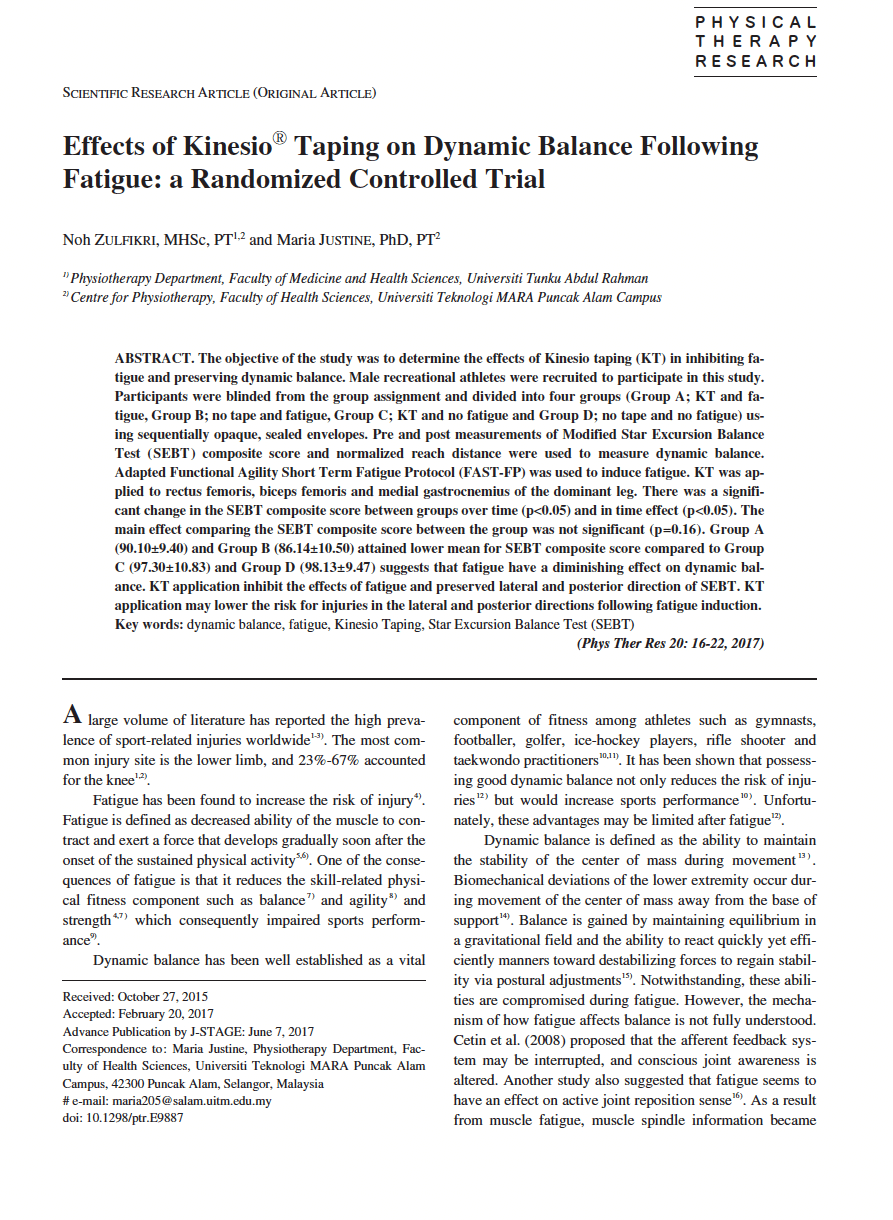Effects of KinesioⓇ Taping on Dynamic Balance Following
Fatigue: a Randomized Controlled Trial
Noh ZULFIKRI, MHSc, PT1,2 and Maria JUSTINE, PhD, PT2
Maria Justine, Physiotherapy Department, Faculty
of Health Sciences, Universiti Teknologi MARA Puncak Alam
Campus, 42300 Puncak Alam, Selangor, Malaysia
# e-mail: [email protected]
Abstract
Background-Fatigue has been found to increase the risk of injury4).
Fatigue is defined as decreased ability of the muscle to contract
and exert a force that develops gradually soon after the
onset of the sustained physical activity5,6). One of the consequences
of fatigue is that it reduces the skill-related physical
fitness component such as balance7 ) and agility8 ) and
strength 4,7 ) which consequently impaired sports performance9).
Methods/Materials-This study used a single-blinded, randomizedcontrolled
trial design with pretest and posttest measurements.
Participants were randomly assigned to either one of
the following groups: Group A (tape was applied and participants
were exposed to fatigue), Group B (no tape was
applied and participants were exposed to fatigue), Group C
(tape was applied and participants were not exposed to fatigue)
and Group D (no tape was applied and participants
were not exposed to fatigue). The study protocol was approved
by the university research ethics committee and also
registered with the Australian New Zealand Clinical Trials
Registry (ACTRN12614001204639). The statistical power
was set at 90% while effect size at 0.25 and p<0.05.
Results-A total of 72 male recreational athletes were recruited
and randomly assigned to groups with the mean (SD) age
for Group A was 21.32 (1.29) years, Group B was 21.79
(1.44) years, Group C was 21.11 (1.33) years and Group D
was 21.93 (0.88) years. No significant difference in mean
(SD) age between groups were observed (p=0.19). Similarly,
no significant difference in mean (SD) body weight
between groups were found (p=0.58). The mean (SD) body
weight for Group A was 66.37 (1.58) kg, Group B was
62.58 (2.16) kg, Group C was 65.26 (1.56) kg and Group D
was 63.63 (3.24) kg. Next, the mean (SD) height for Group
A was 1.71 (0.05) meter, Group B was 1.67 (0.06) meter,
Group C was 1.70 (0.06) meter and Group D was 1.68
(0.04) meter. No significant difference in mean (SD) height
between groups were observed (p=0.23).The baseline characteristics
of study participants were illustrated in Table 1.
Conclusion-There are a few conclusions can be drawn from the
present study. Firstly, fatigue significantly reduces the dynamic
balance that may lead to increased risk of sports injury
that is revealed by lower normalized reach distance in
all direction and SEBT composite score following fatigue.
Secondly, KT application inhibits fatigue and preserves dynamic
balance.
Keywords- Dynamic balance, fatigue, Kinesio Taping, Star Excursion Balance Test, Tape with wisdom, Kinesio live different science,




